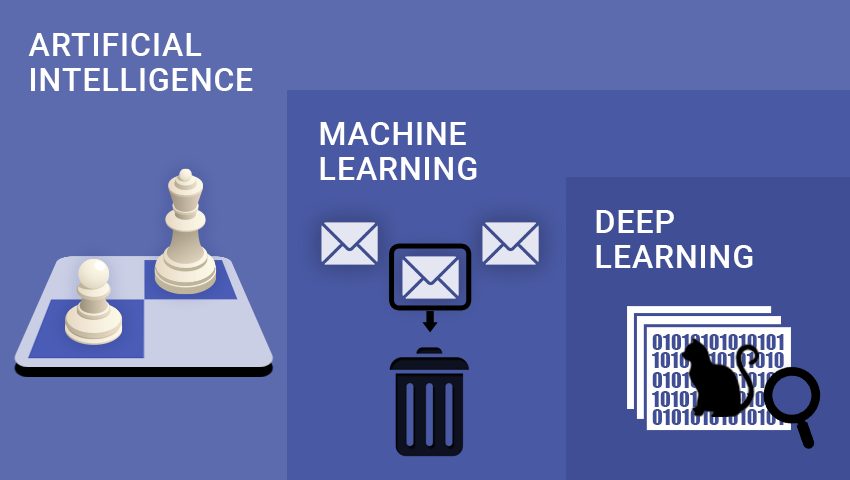
Machine learning vs Deep learning: know the differences
Deep learning, machine learning and artificial intelligence (AI) are the most common terms in the field of information technology. These three technologies are closely related and are often mistakenly considered synonymous.
Learn more about machine learning here >>
However, they are not quite the same. Machine learning is a subset of artificial intelligence, and deep learning is a subset of machine learning. To illustrate, imagine the field of AI as an onion, where AI is the outer layer, machine learning is the next layer, and deep learning is another layer within.

Now let's look at the specifics of each.
Artificial intelligence is a branch of computer science that deals with creating systems capable of performing tasks requiring intellectual abilities. These systems aim to simulate or emulate human intelligence in solving various tasks. Examples of AI include:
Expert systems: programs that use knowledge bases and logic to make decisions in a specific domain, similar to a human expert.
Logic games: computer programs capable of playing games such as chess or Go at a level rivaling superior human players.
Speech recognition systems: programs that can interpret and understand human spoken words.
Planning systems: programs capable of developing strategies and action plans to achieve specific goals.
Natural language processing software: systems that can analyze, interpret, and generate human language.
Robotics: creating robots and autonomous systems capable of performing various tasks, from production operations to assisting in daily life.
Decision support systems: programs that assist in decision-making based on data analysis and recommendations.
All of these examples demonstrate different aspects of artificial intelligence, aiming to create systems capable of "smart" actions and problem-solving.
These are the basics of artificial intelligence. Now, let's move to a brief overview of machine learning.
Machine learning
Machine learning is a subset of artificial intelligence that focuses on developing algorithms and models capable of learning from large datasets. Machine learning algorithms enable computers to discover patterns in data, make predictions, and decisions based on experience without explicitly setting specific rules or instructions.

Machine learning is preferable in situations where:
- There is no explicit algorithm to solve the problem.
- There is a large amount of data for the system to learn from.
- The task is complex, and traditional programming methods are inefficient.
- The ability to generalize and make decisions based on experience is required.
- There is a need for automating the learning process and adapting to a changing environment.
Deep learning
Deep learning is a subset of machine learning that relies on artificial neural networks with multiple layers. This approach aims to mimic the functioning of the human brain in processing and analyzing data, using layers of neurons to extract hierarchical representations.
So when should deep learning be chosen from the entire subset of machine learning? Deep learning should be chosen in cases:
When processing complex hierarchical data structures is required: deep neural networks excel at analyzing and extracting patterns in intricate data like images, sound, and text.
When dealing with a large volume of data: deep learning often requires a substantial amount of data for effective training, making it preferable when extensive datasets are available.
When the task requires a high degree of automation: deep learning can automatically extract features from data, making it a powerful tool for process automation.
In high dimensional data domains: deep learning performs well with high-dimensional data, such as images, where each pixel represents a separate feature.
When you need to solve pattern recognition or classification problems with high accuracy: deep neural networks show their strength in tasks requiring precision in recognition and classification.
The main difference between machine learning and deep learning
Machine learning and deep learning are two crucial areas in the field of artificial intelligence, primarily distinguished by their approach to data processing.

In machine learning, diverse methods like linear regression and support vector machines are employed, often constrained to a small number of layers. In contrast, deep learning operates with deep neural networks, providing a more complex hierarchy of high-level features.
A significant difference lies in feature extraction. In machine learning, this demands manual intervention, while deep learning autonomously extracts features at various levels of abstraction, enabling models to learn more complex representations.
Data volume is another noteworthy distinction. Machine learning can be effective with small datasets, while deep learning often requires substantial data volumes for efficient training due to the larger number of parameters.
Computational resources also play a role. Machine learning can be implemented on less powerful computational structures, while deep learning typically requires powerful computational resources such as graphics processing units (GPUs) or tensor processing units (TPUs).
In conclusion, artificial intelligence, machine learning, and deep learning represent three closely related yet distinct areas of information technology. Artificial intelligence is a general term that encompasses any system that aims to simulate human intelligence. Machine learning provides methodologies for training systems based on data, while deep learning, a subset of machine learning, stands out with multi-layered neural networks capable of automatic feature extraction. The right choice between these approaches depends on the specific task, available resources, and model precision requirements. Together, they form fundamental tools for creating intelligent systems that bring significant changes to various aspects of our lives.
Maria Lipa, QuData developer
